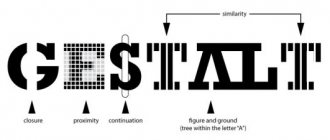Fritz Perls
Fritz Salomon Perls (1893-1970) is considered the founder of the Gestalt therapy method His basic education was psychoanalysis and Perls practiced it for a long time. The beginning of the history of Gestalt therapy can be considered the appearance of the book “Ego, Hunger and Aggression” (1942), which presents a rather radical rethinking of the theory of Sigmund Freud, the founder of psychoanalysis.
Distinctive features of Gestalt therapy
Despite the fact that Fritz Perls himself believed that the theory was built on the basis of psychoanalysis, it is quite obvious that his brainchild was influenced by many different approaches to psychotherapy, as well as the philosophy of existentialism and the ideas of movements - Zen Buddhism and Taoism. Thus, the author placed an obvious emphasis on the flow of the individual’s immediate experiences (“here and now”) - thoughts and feelings, and also declared a person’s personal responsibility for the state of his own consciousness.
A distinctive feature of the Gestalt method is the shift in emphasis in relation to the construction of the most important issues of psychotherapy from the question “why” to the questions “what” and “how”.
This seemingly insignificant change had a huge impact on the course of the process itself, because from this perspective the client’s personal history faded into the background, and his actual experience in the present became the most important. From this it is not difficult to understand that this radically changed the psychoanalytic approach to the work of a psychologist.
Despite the fact that Perls left quite a lot of works devoted to the method, none of them contain any systematic presentation of the material - none of his books can be called a textbook on Gestalt therapy. This seemingly strange fact fits well with the concept of the author, who always believed that the only way to understand the method is practical experience in mastering it. For this reason, many of his works contain a large number of descriptions of techniques and work with clients, but rarely their theoretical justification.
However, after Perls's death in 1970, his followers made an attempt to fill this gap by releasing a manual book called Integrated Gestalt Therapy (E. Polster, M. Polster, 1973). It is on the basis of these data that the theoretical justification of the method is presented, which, without a doubt, is necessary.
Theory and practice of Gestalt therapy by F. Perls.
⇐ PreviousPage 7 of 20Next ⇒Gestalt therapy. Fritz (Frederick) Perls (1893–1970) is considered the creator of Gestalt therapy. Theoretical principles of Gestalt therapy. Figure and background . Human behavior is driven by various needs that arise when the mental or physical balance of the body is disturbed. Soul and body form an inseparable whole. At a given (specific) moment in his life, a person perceives the events that happen to him as the most important in his life, forming a gestalt (figure) in his mind, and less important events fade into the background (background). The construction and completion of gestalts is a natural rhythm of the body’s life. Man, as a self-regulating being, can achieve optimal balance within himself, between himself and the environment. Complete balance corresponds to a clear figure (gestalt), and its incompleteness encourages the body to form a background. The figure (gestalt) can be a desire, feeling or thought that currently prevails. An incomplete gestalt that affects a person’s mental state is the result of an unsatisfied need. Blocking unfinished gestalts is the basis of neurosis. The task of the psychotherapist is to help the client realize his need, make it more clear (i.e. form a gestalt) and ultimately neutralize this need (i.e. complete the gestalt).
Gestalt therapy often uses the following methods of influence: directive, feedback, interpretation. The Gestalt therapist may act somewhat aloof during a session, and his respect for the client is shown only when he becomes himself. He can be demanding, seeking trusting relationships. According to many practicing psychologists, Gestalt therapy produces faster changes compared, for example, with client-centered therapy, but it also has a potentially destructive effect if the psychologist wants to achieve change too quickly. The client may perceive the psychologist as a “guru.” On the one hand, this instills faith in him and increases the possibility of positive changes, on the other hand, it increases the danger of becoming dependent on a charismatic therapist.
1. Perception - “here-and-now”. Gestalt therapy methods help the client perceive the world now, and not in the past or future. Although previous experiences are also discussed, dreams of the future, the emphasis is on their connection with current, momentary sensations and experiences. If the client talks about any events of the past, then he can be asked to transfer the action to the present with the help of fantasy and talk about the events as if they were happening at the moment.
2. Directiveness, or direction of behavior. In some situations, the psychologist tells the client what to do: he offers to perform certain actions, gives instructions and directions regarding what needs to be done at the moment. Additional effect is given to directives by feedback, questions related to feelings, and interpretation. Such an experiment causes certain experiences in the client that can change his point of view on his previous behavior, experiences, and relationships with people.
3. Speech changes. The Gestalt therapist, as a rule, strives to change questions to statements. Most questions are nothing more than statements in disguise. (The question “Do you love me?” may actually mean “I'm not sure you really love me.”) The Gestalt therapist encourages the client to replace questions with I statements, thereby increasing self-identification and specificity. The client is encouraged to speak in the present tense (“Everything is happening here and now”), which helps to focus on the problem. Therefore, “how” and “what” questions are preferable to “why” questions that guide the conversation in an intellectual direction.
4. Dialogue between “top” and “bottom” dogs (“top-dog”
and
"underdog").
This technique is associated with the client’s presence of various splits, fragments, opposites of personality.
To increase the effectiveness of personality functioning, it is necessary to integrate split parts, opposing fragments of the personality, overcome internal barriers and establish connections between these fragments. When a client experiences splitting, the Gestalt therapist suggests conducting the following experiment: identifying with each part of the conflict in turn and conducting
An authoritarian, demanding “top” dog is characterized by the presence of the words “must” and “obliged”. The “bottom” dog, on the contrary, is passive, with a feeling of guilt, it makes excuses and seeks forgiveness. Similar dialogues can take place between other significant personality polarities: between aggressive and passive, male and female, virgin, right hand, etc. Dialogue between split fragments helps the client understand himself better. ,
5. Working with dreams. Paraphrasing Z. Freud, F. Perls says that “sleep is the royal road to personality integration.” He believes that a dream is a projection of our personality, and individual elements of a dream are alienated parts of our personality. To achieve integration, it is necessary to combine the various elements of the dream, to recognize the alienated, projected parts of the personality as one’s own. By “working through” individual dream elements by identifying with them and speaking monologues on their behalf, the hidden content of the dream is revealed through its experience.
When certain dreams are repeated, there is a high probability that behind this lies an important existential problem for the client. There are four stages in working with dreams. At stage 1, the client tells the content of his dream. At the 2nd stage, he retells the dream, changing the past tense to the present, as if the client is dreaming the dream now. At the 3rd stage, the client, as a director, forms a scene that includes elements of a dream. In Stage 4, the counselor encourages the client to transform into the various elements of his dream, using techniques to create dialogue between the various people, objects, or parts of the ego that collide with each other. Such encounters give the client the opportunity to integrate the alienated parts, to identify with them through the assimilation of projections. However, it is not necessary for clients to work through all the sleep.
Recently, employees of the Moscow Gestalt Institute have proposed a number of their own ideas for working with dreams. An interesting technique is D. Khlomov’s “Antison”. It is based on the theoretical position of Gestalt therapy about the opposites that make up both the conscious and the unconscious. The work is carried out as follows. The client sequentially tells his dream to the psychologist. The latter selects and writes down all nouns, adjectives and verbs. The client is then asked to find an antonym (opposite) for each word. After this, the psychologist tells the client a new story (dream), which consists of antonyms chosen by the client. As our work experience has shown, this technique is well used when the client has a very unpleasant dream, and the client is inclined to attribute to it “some mystical content.”
6. Opposites (reverse) Sometimes the client's overt behavior represents a denial of deep and hidden desires, a contradiction with what he really wants. “For example, a person who is a “soul, believing that they more accurately convey a person’s feelings than language. The client's movements, gestures, and postures sometimes carry important content. By inviting the client to strengthen, exaggerate an unexpected movement or gesture, an important discovery can be made.
8. Identifying fantasies. This technique is used to speed up the process of Gestalt therapy. The Gestalt therapist encourages the client to describe his fantasy regarding the figures being discussed or the therapist himself. Feedback from the client regarding fantasies about the therapist is regarded as a projection of the client's qualities onto the therapist.
⇐ Previous7Next ⇒
Didn't find what you were looking for? Use Google search on the site:
Gestalt therapy theory
The central concept of the method is the concept of figure-ground, which is reflected in the term “gestalt,” which translated from German means “whole, integration, form, stereotype.” This concept was also fundamental in Perls’s understanding of another important part of his theory - the substantiation of the important chain of need-satisfaction, from which came the idea of self-actualization, which gained great popularity in the 50-60s of the last century and became one of the foundations of the humanistic method of therapy.
The main background of F. Perls's idea was his attitude towards the individual as a single whole and the consistent rejection of the concepts of dualism of mental and material realities, thoughts and feelings, as well as human behavior. It is easy to see that the same approach underlies the philosophy of holism.
Based on this attitude towards the individual, the natural consequence was the idea that people are not completely influenced by external circumstances and the circumstances of their personal history, and therefore may well play a decisive role in their condition and behavior and bear full responsibility for the events of their lives and their lives. quality. From this came the humanistic concept of actualization, which proclaimed freedom of choice, use of personal potential and the will to change, which underlie the transformation of the individual. The second important consequence was the already mentioned attitude towards what underlay the essence of the human personality, which was henceforth determined by the question “how” and not “why”.
Basic principles of Gestalt therapy
Gestalt therapy techniques are based on the basic principles of this direction. The website for psychotherapeutic assistance psymedcare.ru highlights the following principles:
- "Here and now". A person must concentrate on the feelings, thoughts, sensations that are happening to him now. If he talks about the past, he must pronounce words as if this is happening to him now.
- "I, you". Teaching a person to openly and directly address the person he is talking about.
- Continuum of consciousness. Concentrating on the flow of thoughts and feelings that are happening at a given second, refusing to constantly analyze the situation and statements.
- Subjectivization of statements. Teaching a person to talk about himself, his body, failures, etc. in such a way that he “disturbs” himself, “does not help,” “does not give,” etc. It seems to a person that someone from the outside is preventing him from living happily. In fact, he himself is the author of his own misfortunes.
The biggest mistake you can make is being happy in the past. All people know that life can be both joyful and sad. However, after the “black streak” there is always a “white” streak, and you should not forget about this when you again encounter troubles and problems that will force you to return to those memories when you lived carefree.
Why does a person live in the past? If you are immersed in past memories and do not want to get out of them, this only means that real life does not capture you, does not make you happy, and is not filled with something interesting and new. Your life is boring now or you are mired in a lot of problems, which is why you decided to go back to memories of a time when everything was good, fun and carefree.
However, this is a trap. You returned to the past, not wanting to see the present state of affairs. Why would you go back to the present time if you are already happy by remembering the past when you were successful? This is a mistake that simply plunges you into a state of depression and hopelessness.
First, you live in the past without paying attention to the present. Accordingly, you are unhappy “here and now”, but happy “then and there”. Secondly, if you are constantly in the past, it means that you are not solving the issues that made you run away from the present. You avoid the problems that are hanging over you now, not realizing that they will not go away and will remind you of themselves every time you return to the present.
Don't be happy in the past. Let your past life be an indicator that you can achieve something and solve problems. Let the past be your incentive to not give up in the present while you solve the problems that have arisen. And once you learn to cope with your current troubles without avoiding them, you will become more confident in yourself, stop giving up before every failure and realize that you are living a happy life.
A past life is an indicator that you can be happy. But even then, in the past, you had to overcome certain difficulties in order to achieve success. This gives you the understanding that now you need to continue to live in the present, overcome obstacles, so that in the future you can return to the present and again believe in yourself that you can achieve everything and cope with everything.
Human nature in the context of Perls' theory
The principle of holism (integrity). In general, this principle says that the state of the whole is not determined by a simple summation of the states of its elements, but is a single whole and qualitatively different from this sum. At the same time, in themselves, the processes and states of individual parts of this whole are exhaustively determined by the nature of the whole itself. In other words, a person functions as a single organism, whose physiology, thought processes, and emotions cannot be divided and studied separately.
Human emotions have three aspects - they can be functions of thinking, physiology and senses.
The principle of homeostasis, plus dialectics. Perls applied this principle to the psychological reality of the individual, believing under it the ability of the system to maintain the internal balance (constancy) of its state through opposition (comparing opposites). Logically assuming that human thinking is associated with an understanding of opposites and is actually based on their opposition (evaluation), Perls put forward the concept of psychological balance of the individual. This concept was that any organism has a desire for balance or equilibrium, that is, peace and absence of change.
In Perls's understanding, the thought process was based on comparison, when one thing could only be known in the context of its opposite (without cold there is no hot, without good there is no evil, etc.).
Every moment, a single organism was affected by many different factors, both external and internal, naturally striving to upset the balance of the entire system as a whole. As a result of the desire to preserve the original state, an opposite tendency develops to restore the overall balance. This tendency is a basic need of the body and in the process of this self-regulation an image of the current need is created, with which the desire to satisfy it is currently associated. The need may or may not be satisfied, but in any case, in the process a figurative figure-ground situation (or gestalt) is created - an image of a significant need against the background of content that is less significant at the moment. This is due to the peculiarities of human perception - to perceive things intentionally, that is, to always fix attention on a specific significant object, which is what phenomenology talks about.
In the process of satisfying a significant need, psychological stress decreases, balance is restored, that is, the current need-satisfaction situation ends.
So, the mentioned homeostasis is a process during which a person satisfies his need over and over again, returning the desired balance.
According to Perls, since external and internal factors constantly (simply by virtue of their presence) tend to throw the system out of balance, the process of the emergence of needs and their satisfaction arises again and again. In this case, needs are understood as both physiological and psychological, which is natural if we understand the body as a whole. As for relations with the outside world in the context of satisfying needs, Perls identified two strategies of behavior - autoplastic (the desire to adapt behavior to the outside world) and alloplastic (adaptation of the outside world to one’s interests).
From the above, it can be understood that the figure-ground state (or gestalt) arises as an image of awareness of the current need and, due to the continuity of the process, is a constantly incomplete state that creates psychological tension, since the gestalt certainly requires completion (the need must be realized) . The dominant need creates what is called a figure in Gestalt, and less significant needs temporarily fade into the background.
Perls's attitude to human consciousness in the context of current needs is indicative. He believed that it is not just some kind of system serving these needs, but the very essence of consciousness, identical to the need and the situation that unfolds around it. That is, consciousness is the emergence and development of a need, as well as ways of its implementation - establishing relationships with the world, oneself, etc.
Personality and dominant instincts. According to Sigmund Freud's theory of personality, the basic human instinct was the sexual instinct and, in accordance with this view, the basic human need was the sexual need. Fritz Perls, without questioning this premise, nevertheless argued that such a view is one-sided and does not fully take into account another original biological need of man - the need for food. Purls called this need the hunger instinct. Thus, he identified two basic needs.
Purls associated the hunger instinct with certain events in human development related to the satisfaction of this need at an early age. These are the four stages of human development - prenatal (intrauterine), predental (associated with satisfying hunger through sucking), incisor (biting), molar (biting and chewing). From Perls’s point of view, these four stages had a direct connection with the psychological characteristics of the individual, so the predental was associated with impatience, the incisor with aggression, the molar with assimilation (or assimilation). Thus, by analogy with the stages of development, the most mature human behavior is always associated with assimilation (not only of food, but in general of all information coming from the outside world).
Aggression and defensive behavior. According to Perls, aggression carried an important biological function, ensuring the satisfaction of needs through contact with the environment. The role of aggression was to remove obstacles to a significant need. Moreover, its true goal was precisely the removal of obstacles, and not destruction, since the destruction of any object presupposes the impossibility of its use (assimilation) in the future. If we draw a parallel with the process of satisfying the hunger instinct, then there is undoubtedly a connection with the process of biting and subsequent chewing of food.
According to Perls, the impossibility of realizing the natural manifestations of biological aggression (its suppression) led to obvious psychological problems and here there is an obvious analogy with Freud's theory of suppressed aspirations of ID.
Defense is an instinct associated with self-preservation, and it can take various forms, from aggressive behavior to flight.
The principle of reality. A person is always in the process of interaction with the world around him, and since this communication is always connected with the satisfaction of needs, therefore, a person is not limited to simply perceiving events, but actively intervenes in this process. It is important to clarify that this intervention applies to both the external and internal world (psyche). To realize one’s needs, it is advisable to conditionally divide the world into external and internal, therefore, each individual in the process of development creates this division, which is why the concept of subject and object arises in consciousness. The boundaries between these two worlds follow the line of our interests, because man creates this division himself, and this boundary is in the process of constant change, depending on many factors - physiological instruments of perception (sense organs), the needs of the individual, his ideas about the external and internal, from self-concept, etc. Moreover, in general, this is the boundary of contact with the environment, along which events occur.
The concept of Ego in Pearls' theory. The ego is inextricably linked with interaction with the outside world, this interaction is the reason for its appearance, and the boundaries of the EGO are determined by the boundaries of this contact. According to Perls, a person functions as a person only in the place of meeting with what he considers alien (different from the self).
Subjective awareness of oneself as separate from the world is the essence of the Ego.
According to the Gestalt concept, the ego personality is always considered in the context of its needs.
Personal development. The essence of personality development and change is the satisfaction of constantly emerging needs, which occurs through the assimilation of fragments of the surrounding world. Essentially, this is a continuous chain that looks like this: need - imbalance - aggressive contact - satisfaction through assimilation - new equilibrium , etc. Thus, the personality is almost always in a state of another unfinished gestalt (unsatisfied need). Based on this principle, understanding a psychologically healthy individual is possible only in the context of constant satisfaction of needs, or otherwise, a constantly completing gestalt, and if so, then the concept of psychological growth (actualization) also follows from this, and this is a movement towards the ability to become more and more effective “ cover” an urgent need.
The formation of complete and comprehensive gestalts is a prerequisite for mental health and growth” (F. Perls. 1951).
Gestalt therapy by Frederick Perls
Gestalt therapy (translated from German as “image”, “figure”, “background”) is a method of psychotherapy that promotes the spread of human consciousness, and on the basis of this the achievement of greater intrapersonal integrity, fullness and meaningfulness of life, improved contact with people around and outside world. The origins of the development of Gestalt therapy were the German psychiatrist and psychoanalyst Frederick S. Perls. Thanks to his scientific work and the contribution to the development of a new direction by a number of scientists, including his wife Laura, Gestalt therapy has now gained significant popularity in Europe. Many people who were unable to solve their personal problems turned to psychoanalysts who actively use Gestal therapy methods to provide them with psychotherapeutic assistance. A considerable number of institutes are engaged in the practice and teaching of Gestalt therapy in all parts of the world.
Basics of Gestalt Therapy
First, let's explain what gestalt is. This concept is a kind of organization of parts that makes up a single whole. Those. in our perception we choose what is most important and significant for us, for example, the feeling of hunger forces us to look for certain food that can quickly eliminate this feeling, the rest at the moment does not matter at all for the time being. And as soon as saturation occurs, attention switches, in other words, we first of all pay attention to the most significant figures (this could be the image of a person close to us, a feeling of hunger, a headache), and other details remain unnoticed, disappear into the so-called background.
Human nature
In the theory of Gestalt therapy, nature is presented as a powerful, self-replenishing force, which is characterized by as many physiological and animal factors as social and cultural ones. Here we recognize the primacy of living conditions.
Field "organism-environment"
Since the existence of a human animal also includes his environment, the theory widely uses the concept of “field”, “organism-environment”, i.e. its essence is its integrity and continuity with the environment.
Self-regulation
There is not a single vital function of a living creature that does not include contact with the environment. The theory of human-animal nature contains the principle of self-regulation, which will only be good if the “organism-environment” field is not distorted in any way.
Contact and contact boundary
Contact is how a person interacts with an object or its environment, which provides different ways of guiding them. It is also the ability to give up inappropriate ways to satisfy yourself. Any contact is considered precisely the creative adaptation of a person to the environment, thanks to it, he confirms the preservation of his unique existence.
Dominance
Gestalt drawing To make contact, it is important that the figure we are aware of is separated from the background. It is this that creates the dominance of the field, which prevails over other objects that are not significant to us. The goal of Gestalt therapy is to activate our ability to interact with images, to build them in adequate connection with the background.
Acute situation and therapeutic situation
Based on the above concepts and operating with them, Gestalt therapy analyzes suffering, neurosis and all the difficulties for which people turn to a psychotherapist. And the surprising thing is that the symptom is a consequence of the already mentioned creative adaptation of a person to the environment. This makes clear the psychotechnical techniques used by psychoanalysts to bring a person to an awareness of his problems and failures and to independently develop ways to solve them.
Objectives of Gestalt Therapy
Thus, we have clarified the task of the psychoanalyst, which boils down to attempts to support a person’s ability to isolate gestalt figures, separate them from the background, allow them to unfold and come into contact, build and collapse. If I am driving a car, the images I recreate consist of the landscapes I saw, but if I see an obstacle, these images disappear and are replaced by images of immediate danger on the road. This sequential creation and destruction of Gestalt images is called the contact cycle, which includes four phases:
- pre-contact - contains the background or background, which is our body and a feeling or desire arises in it, indicating the presence of an actual need at this moment;
- contacting - an image that stands out from the chaotic background itself recedes into the background. From this time on, energy accumulates and enables a person to turn to the environment to explore all the ways available in it in order to find satisfaction of his needs;
- final contact - now the environment itself leaves the field of attention and a new image appears - the selected object;
- post-contact - there is no longer a figure or a field, nothing relevant remains and the need is either satisfied or replaced by another, different from the previous one.
In life, we may not complete this sequence of phases.
For example, I want to call my friend (pre-contact phase), I go to the phone, take it in my hand, dial the number (contact phase), but suddenly my actions are interrupted by the doorbell, and I put the phone down. Here we are dealing with another important concept in Gestalt therapy: “incompleteness of the situation.” In our case, the telephone conversation did not take place due to the more pressing need to open the door to the person who came; there was no choice here, and the sequence of phases was disrupted. In life, most of us very often interrupt this sequence in one situation or another. A pathogenic situation is created when I leave an unfinished situation, find myself in a situation of hopelessness or lack of rational choice (in this case, with a postponed telephone conversation), and do not return to it. There may be unconscious irritation here, as if you didn’t do everything you planned.
When such an unfinished situation begins to greatly disturb a person, the therapist, with leading questions, gives him the opportunity to understand the interruption in the sequence and change it so that he can again make the right and painless choice.
Games
In Gestalt therapy there are many different games aimed at solving problems.
Unfinished Business
As discussed previously, when clients identify an unfinished task (for example, something they did with their parents, siblings, or friends), they are asked to complete it in order to identify the resentment that is characteristic of the unfinished task. .
Projective game
The one who expresses distrust in his own words is asked to imitate an unreliable person in order to identify and prove his hidden unreliability.
Revealing the opposite
This game is based on the fact that in most cases we behave completely opposite to those feelings and emotions that are deep inside us. For example, a nice young girl is asked to play the role of a “grumpy and angry vixen.”
Rehearsal
Many of us replay certain statements in our minds in various imaginary situations, and the participants in the game share their rehearsal thoughts.
Exaggeration
Any body movement or gesture is deliberately emphasized and exaggerated in order to show its absurdity.
Games used in marriage counseling
Partners express their grievances to each other, and then, having exhausted them, list mutual positive aspects. They are also asked to discover certain external or internal qualities that are noticeable in the other interlocutor, which helps to connect facts with reality, and not with their fantasies.
There are other methods in Gestalt therapy that are aimed at a certain range of problems to be solved, among which there may be a psychotherapeutic effect on people suffering from alcohol addiction, drug addiction, etc. It is important to remember that only a professional has the right to conduct such sessions, since incorrect correction tactics can bring serious complications to the patient’s psyche.
The nature of psychological disorders
Naturally, the nature of the functioning of the individual in a system of needs that arise again and again presupposes constant psychological tension—frustration. And according to Perls, frustration is an important catalyst for personality development, since it is its presence that is the source of all human activity. This is how the child learns to interact with the world and becomes an individual precisely in order to effectively get rid of frustrations (psychological stresses).
All frustrations are caused by an unsatisfied need, and its satisfaction is associated with the assimilation of part of the surrounding world; an example of such assimilation is the satisfaction of hunger - we bite food, chew it and digest it, this is how we receive energy from the outside world and assimilate it through digestion. This process has both physical and mental manifestations, when information or objects can appear instead of a material object (food). However, according to Perls's concept, the instinct of hunger lies at the source of both processes.
Thus, it was with a violation of the satisfaction of needs that Perls associated the emergence of psychological problems.
Why Gestalt Therapy?
The very name Gestalt (German - gestalt, which means form or image) goes back to the popular direction in psychology of the same name at the beginning of the twentieth century, the founders of which were Max Wertheimer, Kurt Koffke and Wolfgang Köhler, who studied the principle of the psyche’s perception of the surrounding world. The main idea of the Gestalt approach was to affirm the ability of the psyche to perceive the surrounding reality in holistic images that are not reduced to a simple sum of their constituent elements, that is, from the point of view of consciousness, the figure in its integrity had meaning, while its components were only the sum of elements , which do not determine the meaning of this whole. As for Perls's Gestalt Therapy, as one of the methods of psychotherapy, this is a completely independent direction in psychology, not directly related to Gestalt psychology, except for a number of ideas borrowed from it and, in fact, the name of the system itself.










